Analysis of the Conceptual Framework for Financial Reporting
VerifiedAdded on 2021/04/17
|15
|3775
|106
Report
AI Summary
This report provides a comprehensive analysis of the conceptual framework for financial reporting. It begins by introducing the framework and its objectives, which include providing useful information for investment and credit decisions, evaluating cash flow projections, and understanding organizational resources. The report then delves into the underlying assumptions, such as the accrual basis and going concern, and the qualitative characteristics that enhance the usefulness of financial information, including relevance, faithful representation, comparability, verifiability, timeliness, and understandability. Furthermore, it examines the key elements of financial statements, namely assets, liabilities, equity, income, and expenses. The report also explores the concepts of capital and capital maintenance, differentiating between financial and physical capital maintenance, and concludes with a discussion on the use of fair values in financial statement preparation and presentation. Overall, the report offers a detailed understanding of the framework's components and their implications for financial reporting practices.
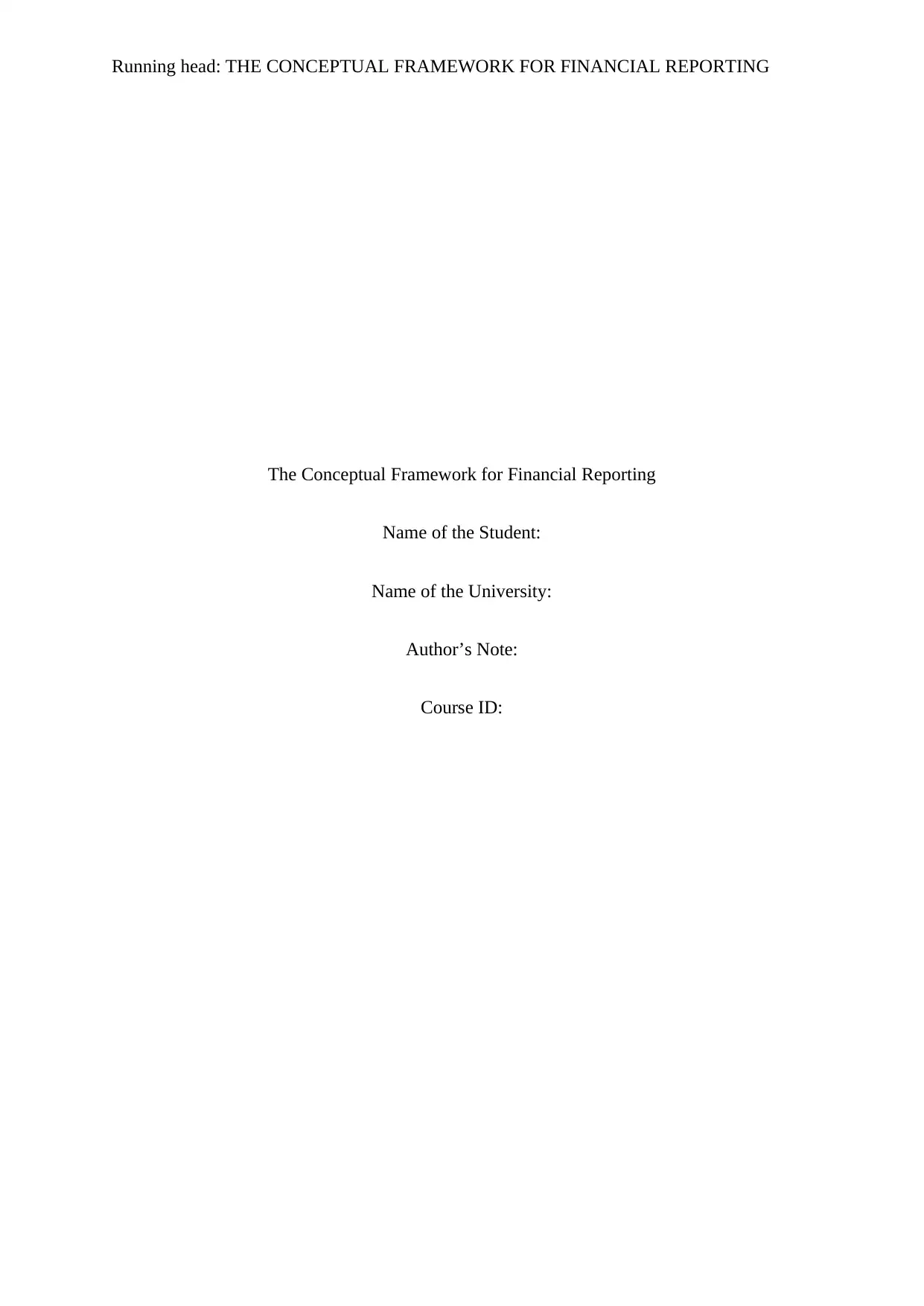
Running head: THE CONCEPTUAL FRAMEWORK FOR FINANCIAL REPORTING
The Conceptual Framework for Financial Reporting
Name of the Student:
Name of the University:
Author’s Note:
Course ID:
The Conceptual Framework for Financial Reporting
Name of the Student:
Name of the University:
Author’s Note:
Course ID:
Paraphrase This Document
Need a fresh take? Get an instant paraphrase of this document with our AI Paraphraser
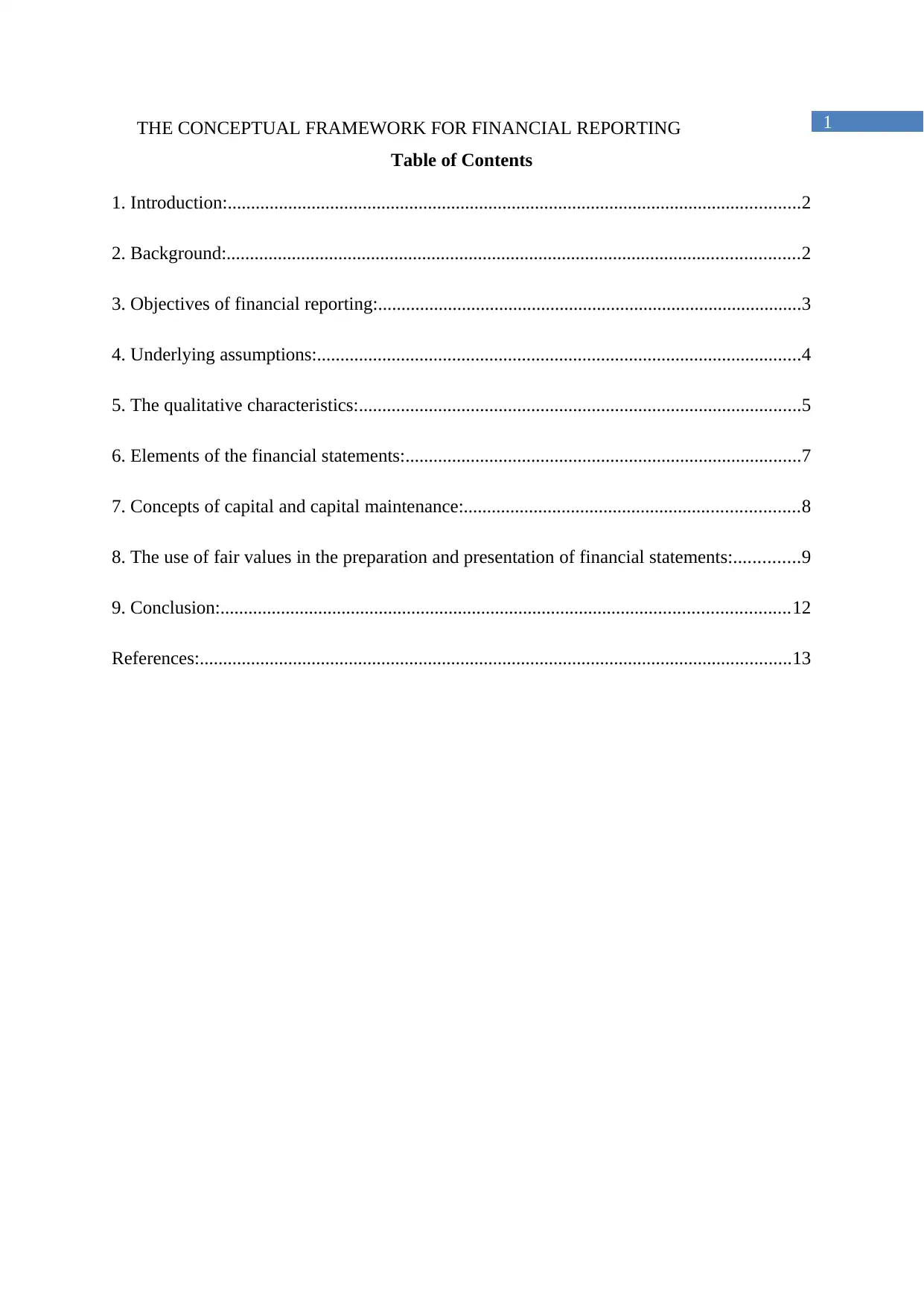
1THE CONCEPTUAL FRAMEWORK FOR FINANCIAL REPORTING
Table of Contents
1. Introduction:...........................................................................................................................2
2. Background:...........................................................................................................................2
3. Objectives of financial reporting:...........................................................................................3
4. Underlying assumptions:........................................................................................................4
5. The qualitative characteristics:...............................................................................................5
6. Elements of the financial statements:.....................................................................................7
7. Concepts of capital and capital maintenance:........................................................................8
8. The use of fair values in the preparation and presentation of financial statements:..............9
9. Conclusion:..........................................................................................................................12
References:...............................................................................................................................13
Table of Contents
1. Introduction:...........................................................................................................................2
2. Background:...........................................................................................................................2
3. Objectives of financial reporting:...........................................................................................3
4. Underlying assumptions:........................................................................................................4
5. The qualitative characteristics:...............................................................................................5
6. Elements of the financial statements:.....................................................................................7
7. Concepts of capital and capital maintenance:........................................................................8
8. The use of fair values in the preparation and presentation of financial statements:..............9
9. Conclusion:..........................................................................................................................12
References:...............................................................................................................................13
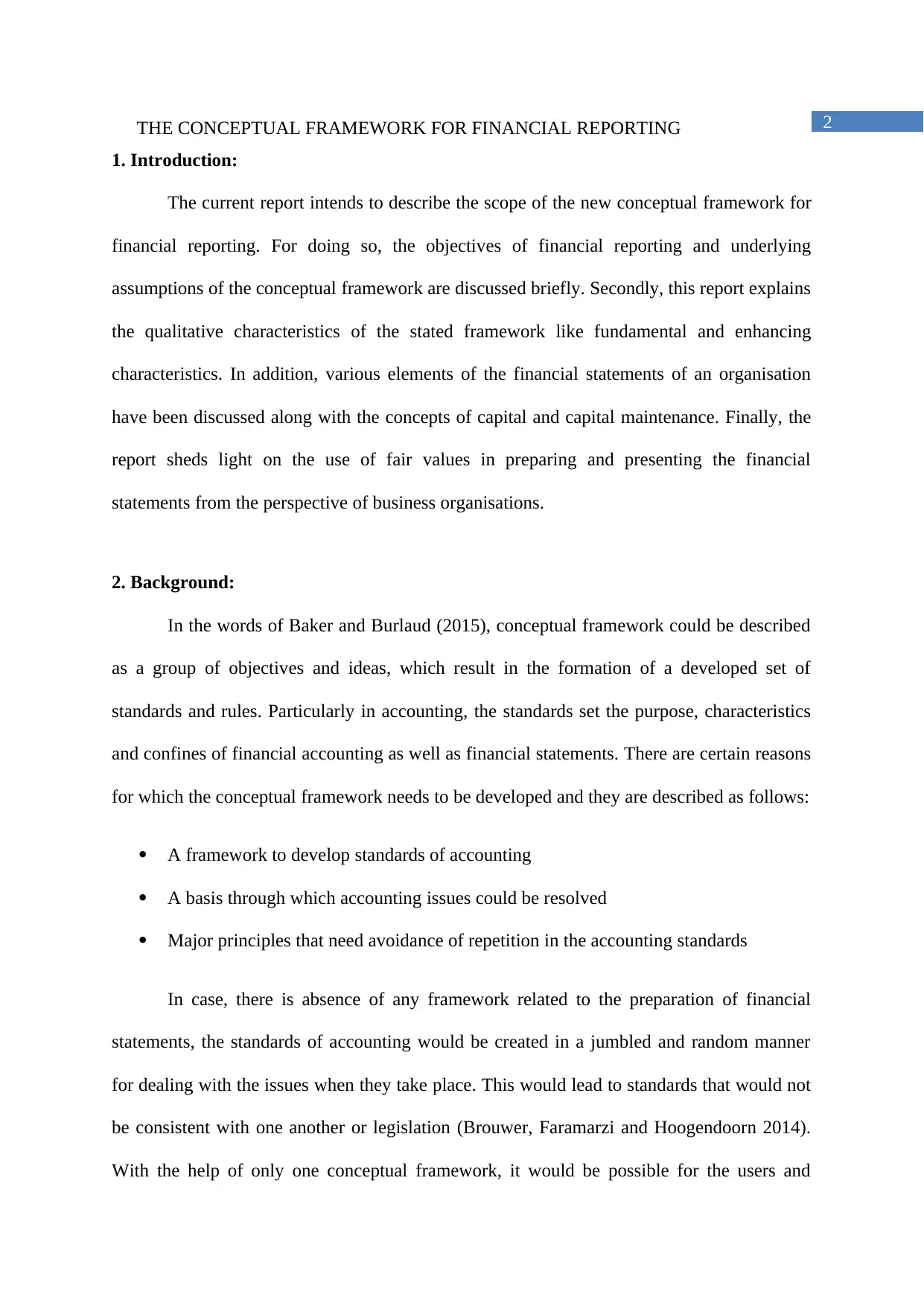
2THE CONCEPTUAL FRAMEWORK FOR FINANCIAL REPORTING
1. Introduction:
The current report intends to describe the scope of the new conceptual framework for
financial reporting. For doing so, the objectives of financial reporting and underlying
assumptions of the conceptual framework are discussed briefly. Secondly, this report explains
the qualitative characteristics of the stated framework like fundamental and enhancing
characteristics. In addition, various elements of the financial statements of an organisation
have been discussed along with the concepts of capital and capital maintenance. Finally, the
report sheds light on the use of fair values in preparing and presenting the financial
statements from the perspective of business organisations.
2. Background:
In the words of Baker and Burlaud (2015), conceptual framework could be described
as a group of objectives and ideas, which result in the formation of a developed set of
standards and rules. Particularly in accounting, the standards set the purpose, characteristics
and confines of financial accounting as well as financial statements. There are certain reasons
for which the conceptual framework needs to be developed and they are described as follows:
A framework to develop standards of accounting
A basis through which accounting issues could be resolved
Major principles that need avoidance of repetition in the accounting standards
In case, there is absence of any framework related to the preparation of financial
statements, the standards of accounting would be created in a jumbled and random manner
for dealing with the issues when they take place. This would lead to standards that would not
be consistent with one another or legislation (Brouwer, Faramarzi and Hoogendoorn 2014).
With the help of only one conceptual framework, it would be possible for the users and
1. Introduction:
The current report intends to describe the scope of the new conceptual framework for
financial reporting. For doing so, the objectives of financial reporting and underlying
assumptions of the conceptual framework are discussed briefly. Secondly, this report explains
the qualitative characteristics of the stated framework like fundamental and enhancing
characteristics. In addition, various elements of the financial statements of an organisation
have been discussed along with the concepts of capital and capital maintenance. Finally, the
report sheds light on the use of fair values in preparing and presenting the financial
statements from the perspective of business organisations.
2. Background:
In the words of Baker and Burlaud (2015), conceptual framework could be described
as a group of objectives and ideas, which result in the formation of a developed set of
standards and rules. Particularly in accounting, the standards set the purpose, characteristics
and confines of financial accounting as well as financial statements. There are certain reasons
for which the conceptual framework needs to be developed and they are described as follows:
A framework to develop standards of accounting
A basis through which accounting issues could be resolved
Major principles that need avoidance of repetition in the accounting standards
In case, there is absence of any framework related to the preparation of financial
statements, the standards of accounting would be created in a jumbled and random manner
for dealing with the issues when they take place. This would lead to standards that would not
be consistent with one another or legislation (Brouwer, Faramarzi and Hoogendoorn 2014).
With the help of only one conceptual framework, it would be possible for the users and
⊘ This is a preview!⊘
Do you want full access?
Subscribe today to unlock all pages.

Trusted by 1+ million students worldwide
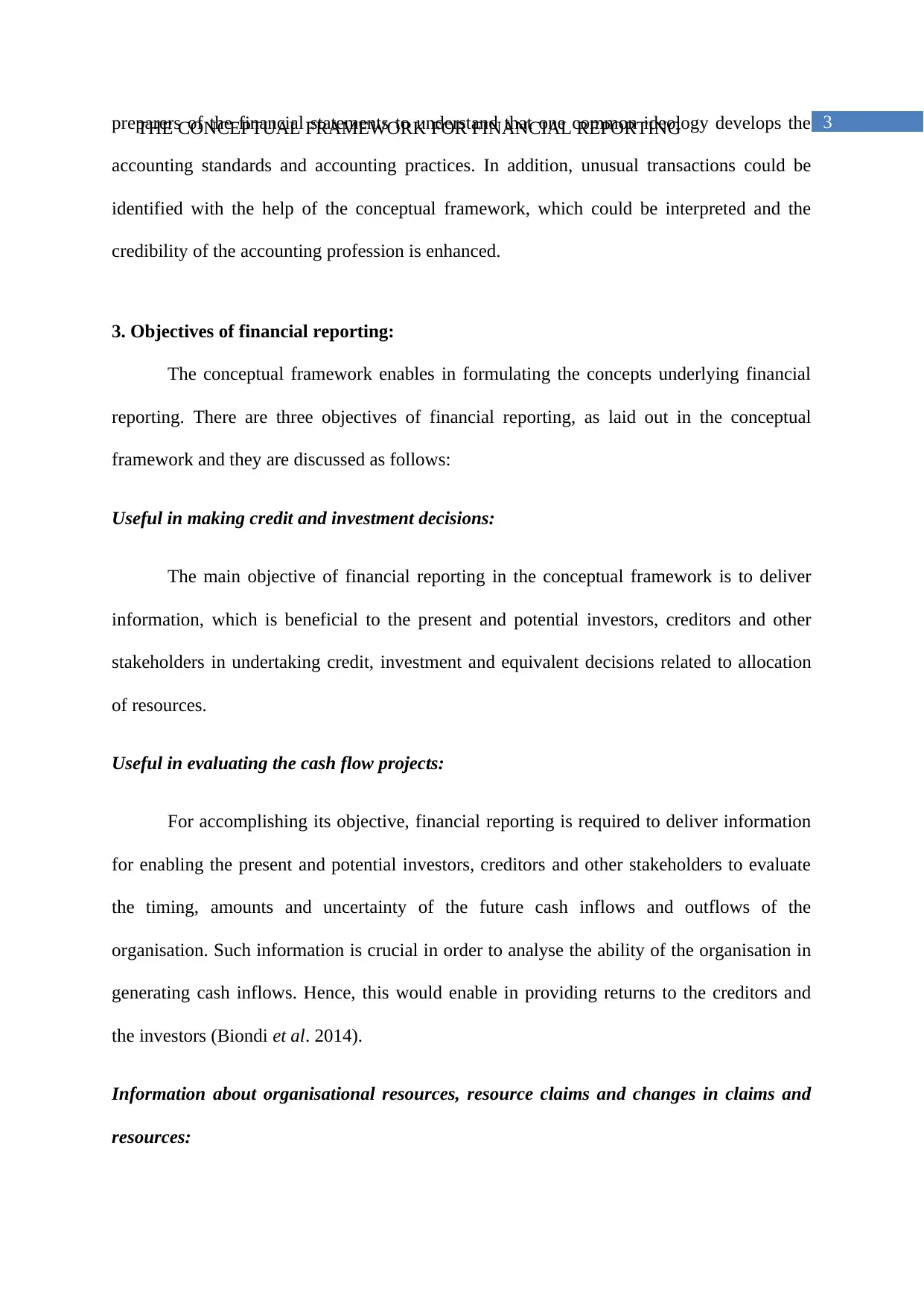
3THE CONCEPTUAL FRAMEWORK FOR FINANCIAL REPORTINGpreparers of the financial statements to understand that one common ideology develops the
accounting standards and accounting practices. In addition, unusual transactions could be
identified with the help of the conceptual framework, which could be interpreted and the
credibility of the accounting profession is enhanced.
3. Objectives of financial reporting:
The conceptual framework enables in formulating the concepts underlying financial
reporting. There are three objectives of financial reporting, as laid out in the conceptual
framework and they are discussed as follows:
Useful in making credit and investment decisions:
The main objective of financial reporting in the conceptual framework is to deliver
information, which is beneficial to the present and potential investors, creditors and other
stakeholders in undertaking credit, investment and equivalent decisions related to allocation
of resources.
Useful in evaluating the cash flow projects:
For accomplishing its objective, financial reporting is required to deliver information
for enabling the present and potential investors, creditors and other stakeholders to evaluate
the timing, amounts and uncertainty of the future cash inflows and outflows of the
organisation. Such information is crucial in order to analyse the ability of the organisation in
generating cash inflows. Hence, this would enable in providing returns to the creditors and
the investors (Biondi et al. 2014).
Information about organisational resources, resource claims and changes in claims and
resources:
accounting standards and accounting practices. In addition, unusual transactions could be
identified with the help of the conceptual framework, which could be interpreted and the
credibility of the accounting profession is enhanced.
3. Objectives of financial reporting:
The conceptual framework enables in formulating the concepts underlying financial
reporting. There are three objectives of financial reporting, as laid out in the conceptual
framework and they are discussed as follows:
Useful in making credit and investment decisions:
The main objective of financial reporting in the conceptual framework is to deliver
information, which is beneficial to the present and potential investors, creditors and other
stakeholders in undertaking credit, investment and equivalent decisions related to allocation
of resources.
Useful in evaluating the cash flow projects:
For accomplishing its objective, financial reporting is required to deliver information
for enabling the present and potential investors, creditors and other stakeholders to evaluate
the timing, amounts and uncertainty of the future cash inflows and outflows of the
organisation. Such information is crucial in order to analyse the ability of the organisation in
generating cash inflows. Hence, this would enable in providing returns to the creditors and
the investors (Biondi et al. 2014).
Information about organisational resources, resource claims and changes in claims and
resources:
Paraphrase This Document
Need a fresh take? Get an instant paraphrase of this document with our AI Paraphraser
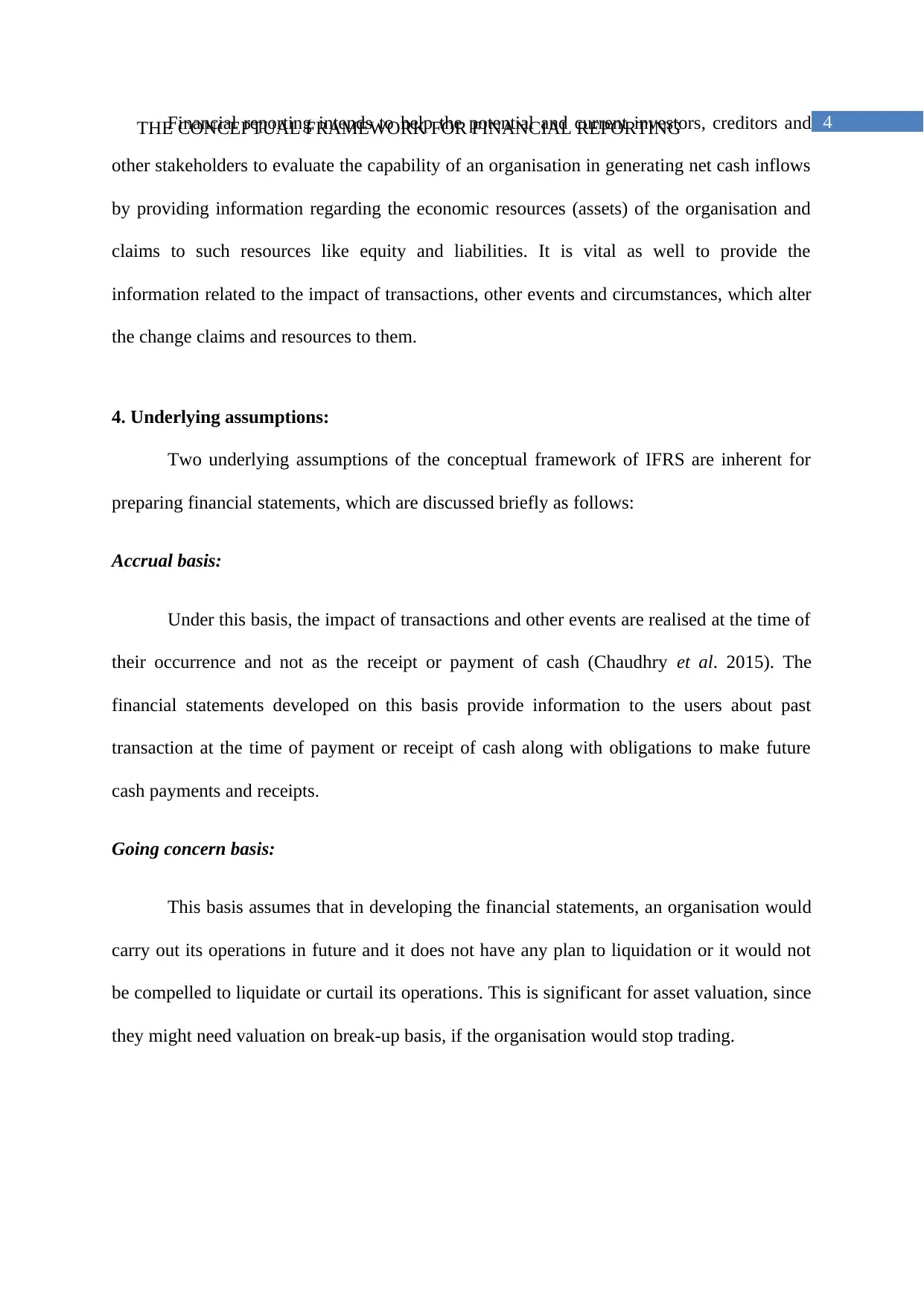
4THE CONCEPTUAL FRAMEWORK FOR FINANCIAL REPORTINGFinancial reporting intends to help the potential and current investors, creditors and
other stakeholders to evaluate the capability of an organisation in generating net cash inflows
by providing information regarding the economic resources (assets) of the organisation and
claims to such resources like equity and liabilities. It is vital as well to provide the
information related to the impact of transactions, other events and circumstances, which alter
the change claims and resources to them.
4. Underlying assumptions:
Two underlying assumptions of the conceptual framework of IFRS are inherent for
preparing financial statements, which are discussed briefly as follows:
Accrual basis:
Under this basis, the impact of transactions and other events are realised at the time of
their occurrence and not as the receipt or payment of cash (Chaudhry et al. 2015). The
financial statements developed on this basis provide information to the users about past
transaction at the time of payment or receipt of cash along with obligations to make future
cash payments and receipts.
Going concern basis:
This basis assumes that in developing the financial statements, an organisation would
carry out its operations in future and it does not have any plan to liquidation or it would not
be compelled to liquidate or curtail its operations. This is significant for asset valuation, since
they might need valuation on break-up basis, if the organisation would stop trading.
other stakeholders to evaluate the capability of an organisation in generating net cash inflows
by providing information regarding the economic resources (assets) of the organisation and
claims to such resources like equity and liabilities. It is vital as well to provide the
information related to the impact of transactions, other events and circumstances, which alter
the change claims and resources to them.
4. Underlying assumptions:
Two underlying assumptions of the conceptual framework of IFRS are inherent for
preparing financial statements, which are discussed briefly as follows:
Accrual basis:
Under this basis, the impact of transactions and other events are realised at the time of
their occurrence and not as the receipt or payment of cash (Chaudhry et al. 2015). The
financial statements developed on this basis provide information to the users about past
transaction at the time of payment or receipt of cash along with obligations to make future
cash payments and receipts.
Going concern basis:
This basis assumes that in developing the financial statements, an organisation would
carry out its operations in future and it does not have any plan to liquidation or it would not
be compelled to liquidate or curtail its operations. This is significant for asset valuation, since
they might need valuation on break-up basis, if the organisation would stop trading.
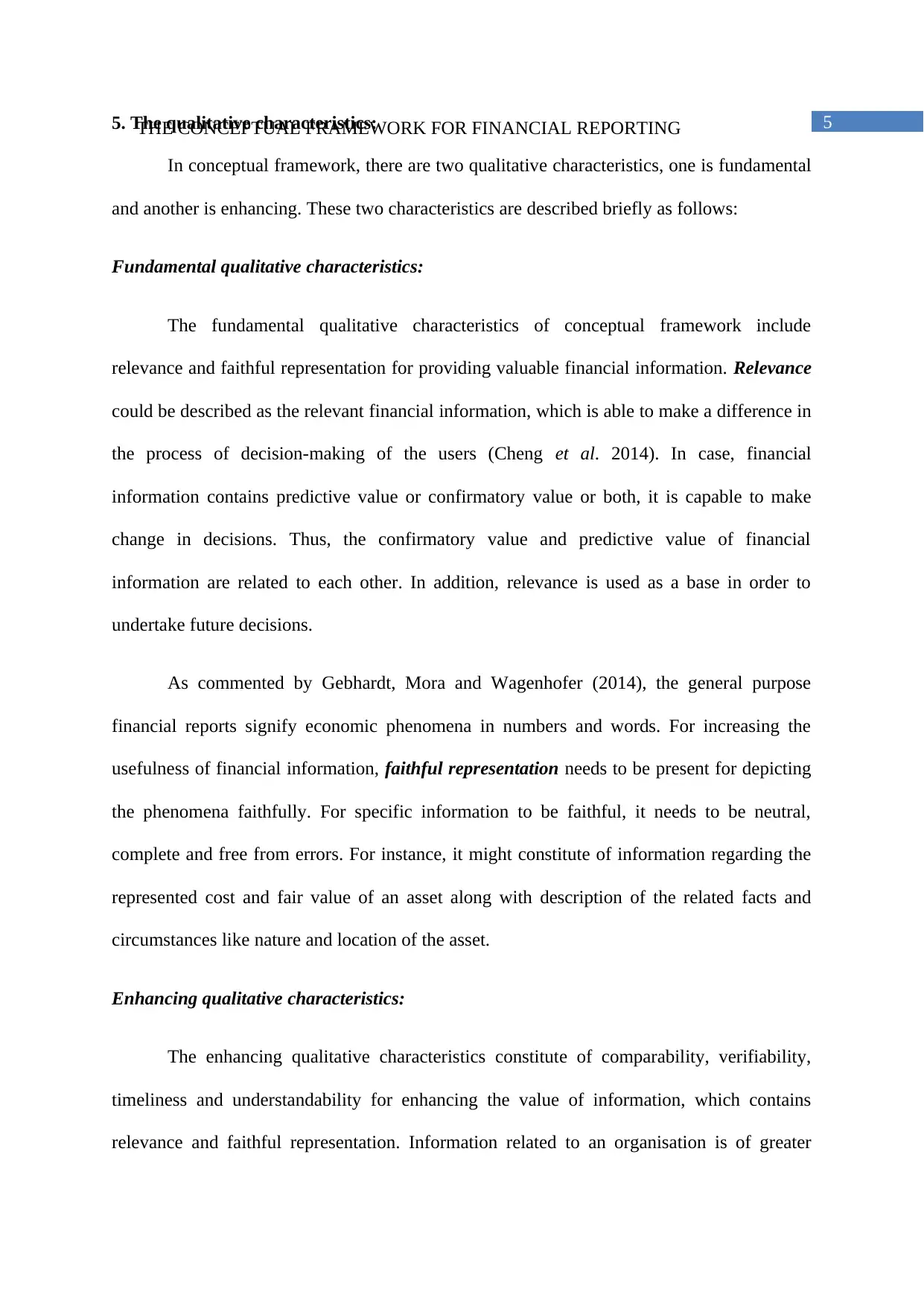
5THE CONCEPTUAL FRAMEWORK FOR FINANCIAL REPORTING5. The qualitative characteristics:
In conceptual framework, there are two qualitative characteristics, one is fundamental
and another is enhancing. These two characteristics are described briefly as follows:
Fundamental qualitative characteristics:
The fundamental qualitative characteristics of conceptual framework include
relevance and faithful representation for providing valuable financial information. Relevance
could be described as the relevant financial information, which is able to make a difference in
the process of decision-making of the users (Cheng et al. 2014). In case, financial
information contains predictive value or confirmatory value or both, it is capable to make
change in decisions. Thus, the confirmatory value and predictive value of financial
information are related to each other. In addition, relevance is used as a base in order to
undertake future decisions.
As commented by Gebhardt, Mora and Wagenhofer (2014), the general purpose
financial reports signify economic phenomena in numbers and words. For increasing the
usefulness of financial information, faithful representation needs to be present for depicting
the phenomena faithfully. For specific information to be faithful, it needs to be neutral,
complete and free from errors. For instance, it might constitute of information regarding the
represented cost and fair value of an asset along with description of the related facts and
circumstances like nature and location of the asset.
Enhancing qualitative characteristics:
The enhancing qualitative characteristics constitute of comparability, verifiability,
timeliness and understandability for enhancing the value of information, which contains
relevance and faithful representation. Information related to an organisation is of greater
In conceptual framework, there are two qualitative characteristics, one is fundamental
and another is enhancing. These two characteristics are described briefly as follows:
Fundamental qualitative characteristics:
The fundamental qualitative characteristics of conceptual framework include
relevance and faithful representation for providing valuable financial information. Relevance
could be described as the relevant financial information, which is able to make a difference in
the process of decision-making of the users (Cheng et al. 2014). In case, financial
information contains predictive value or confirmatory value or both, it is capable to make
change in decisions. Thus, the confirmatory value and predictive value of financial
information are related to each other. In addition, relevance is used as a base in order to
undertake future decisions.
As commented by Gebhardt, Mora and Wagenhofer (2014), the general purpose
financial reports signify economic phenomena in numbers and words. For increasing the
usefulness of financial information, faithful representation needs to be present for depicting
the phenomena faithfully. For specific information to be faithful, it needs to be neutral,
complete and free from errors. For instance, it might constitute of information regarding the
represented cost and fair value of an asset along with description of the related facts and
circumstances like nature and location of the asset.
Enhancing qualitative characteristics:
The enhancing qualitative characteristics constitute of comparability, verifiability,
timeliness and understandability for enhancing the value of information, which contains
relevance and faithful representation. Information related to an organisation is of greater
⊘ This is a preview!⊘
Do you want full access?
Subscribe today to unlock all pages.

Trusted by 1+ million students worldwide
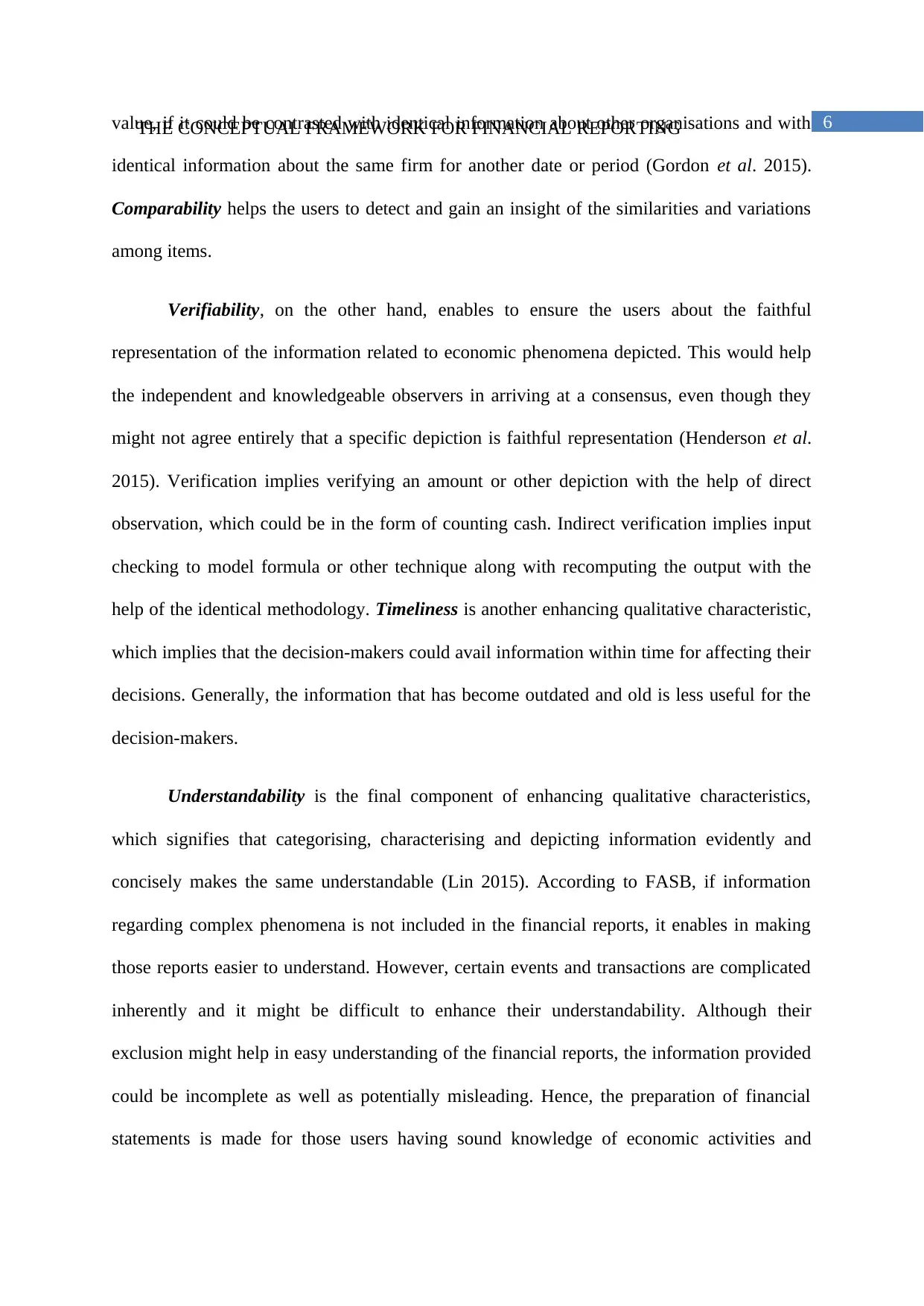
6THE CONCEPTUAL FRAMEWORK FOR FINANCIAL REPORTINGvalue, if it could be contrasted with identical information about other organisations and with
identical information about the same firm for another date or period (Gordon et al. 2015).
Comparability helps the users to detect and gain an insight of the similarities and variations
among items.
Verifiability, on the other hand, enables to ensure the users about the faithful
representation of the information related to economic phenomena depicted. This would help
the independent and knowledgeable observers in arriving at a consensus, even though they
might not agree entirely that a specific depiction is faithful representation (Henderson et al.
2015). Verification implies verifying an amount or other depiction with the help of direct
observation, which could be in the form of counting cash. Indirect verification implies input
checking to model formula or other technique along with recomputing the output with the
help of the identical methodology. Timeliness is another enhancing qualitative characteristic,
which implies that the decision-makers could avail information within time for affecting their
decisions. Generally, the information that has become outdated and old is less useful for the
decision-makers.
Understandability is the final component of enhancing qualitative characteristics,
which signifies that categorising, characterising and depicting information evidently and
concisely makes the same understandable (Lin 2015). According to FASB, if information
regarding complex phenomena is not included in the financial reports, it enables in making
those reports easier to understand. However, certain events and transactions are complicated
inherently and it might be difficult to enhance their understandability. Although their
exclusion might help in easy understanding of the financial reports, the information provided
could be incomplete as well as potentially misleading. Hence, the preparation of financial
statements is made for those users having sound knowledge of economic activities and
identical information about the same firm for another date or period (Gordon et al. 2015).
Comparability helps the users to detect and gain an insight of the similarities and variations
among items.
Verifiability, on the other hand, enables to ensure the users about the faithful
representation of the information related to economic phenomena depicted. This would help
the independent and knowledgeable observers in arriving at a consensus, even though they
might not agree entirely that a specific depiction is faithful representation (Henderson et al.
2015). Verification implies verifying an amount or other depiction with the help of direct
observation, which could be in the form of counting cash. Indirect verification implies input
checking to model formula or other technique along with recomputing the output with the
help of the identical methodology. Timeliness is another enhancing qualitative characteristic,
which implies that the decision-makers could avail information within time for affecting their
decisions. Generally, the information that has become outdated and old is less useful for the
decision-makers.
Understandability is the final component of enhancing qualitative characteristics,
which signifies that categorising, characterising and depicting information evidently and
concisely makes the same understandable (Lin 2015). According to FASB, if information
regarding complex phenomena is not included in the financial reports, it enables in making
those reports easier to understand. However, certain events and transactions are complicated
inherently and it might be difficult to enhance their understandability. Although their
exclusion might help in easy understanding of the financial reports, the information provided
could be incomplete as well as potentially misleading. Hence, the preparation of financial
statements is made for those users having sound knowledge of economic activities and
Paraphrase This Document
Need a fresh take? Get an instant paraphrase of this document with our AI Paraphraser
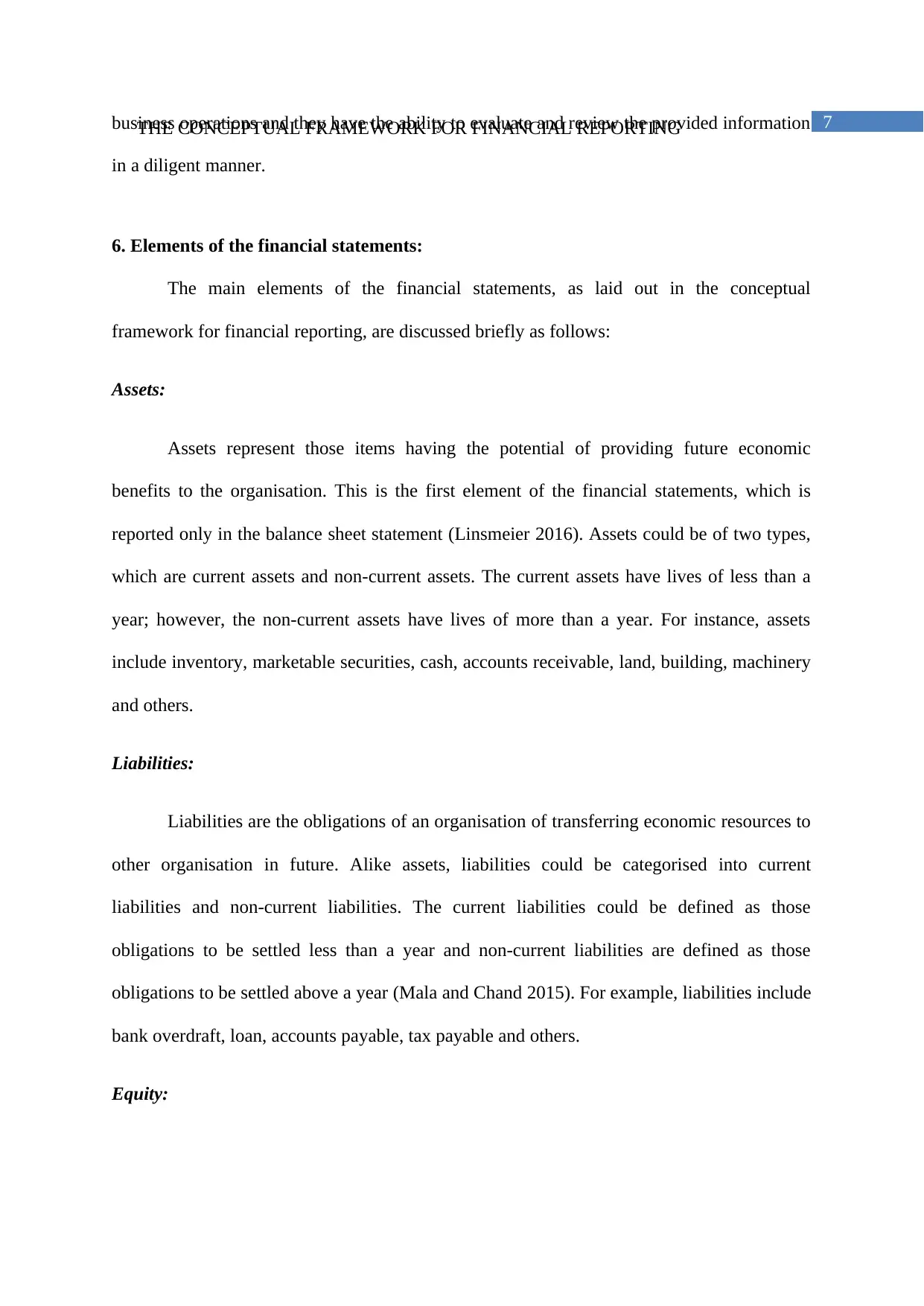
7THE CONCEPTUAL FRAMEWORK FOR FINANCIAL REPORTINGbusiness operations and they have the ability to evaluate and review the provided information
in a diligent manner.
6. Elements of the financial statements:
The main elements of the financial statements, as laid out in the conceptual
framework for financial reporting, are discussed briefly as follows:
Assets:
Assets represent those items having the potential of providing future economic
benefits to the organisation. This is the first element of the financial statements, which is
reported only in the balance sheet statement (Linsmeier 2016). Assets could be of two types,
which are current assets and non-current assets. The current assets have lives of less than a
year; however, the non-current assets have lives of more than a year. For instance, assets
include inventory, marketable securities, cash, accounts receivable, land, building, machinery
and others.
Liabilities:
Liabilities are the obligations of an organisation of transferring economic resources to
other organisation in future. Alike assets, liabilities could be categorised into current
liabilities and non-current liabilities. The current liabilities could be defined as those
obligations to be settled less than a year and non-current liabilities are defined as those
obligations to be settled above a year (Mala and Chand 2015). For example, liabilities include
bank overdraft, loan, accounts payable, tax payable and others.
Equity:
in a diligent manner.
6. Elements of the financial statements:
The main elements of the financial statements, as laid out in the conceptual
framework for financial reporting, are discussed briefly as follows:
Assets:
Assets represent those items having the potential of providing future economic
benefits to the organisation. This is the first element of the financial statements, which is
reported only in the balance sheet statement (Linsmeier 2016). Assets could be of two types,
which are current assets and non-current assets. The current assets have lives of less than a
year; however, the non-current assets have lives of more than a year. For instance, assets
include inventory, marketable securities, cash, accounts receivable, land, building, machinery
and others.
Liabilities:
Liabilities are the obligations of an organisation of transferring economic resources to
other organisation in future. Alike assets, liabilities could be categorised into current
liabilities and non-current liabilities. The current liabilities could be defined as those
obligations to be settled less than a year and non-current liabilities are defined as those
obligations to be settled above a year (Mala and Chand 2015). For example, liabilities include
bank overdraft, loan, accounts payable, tax payable and others.
Equity:
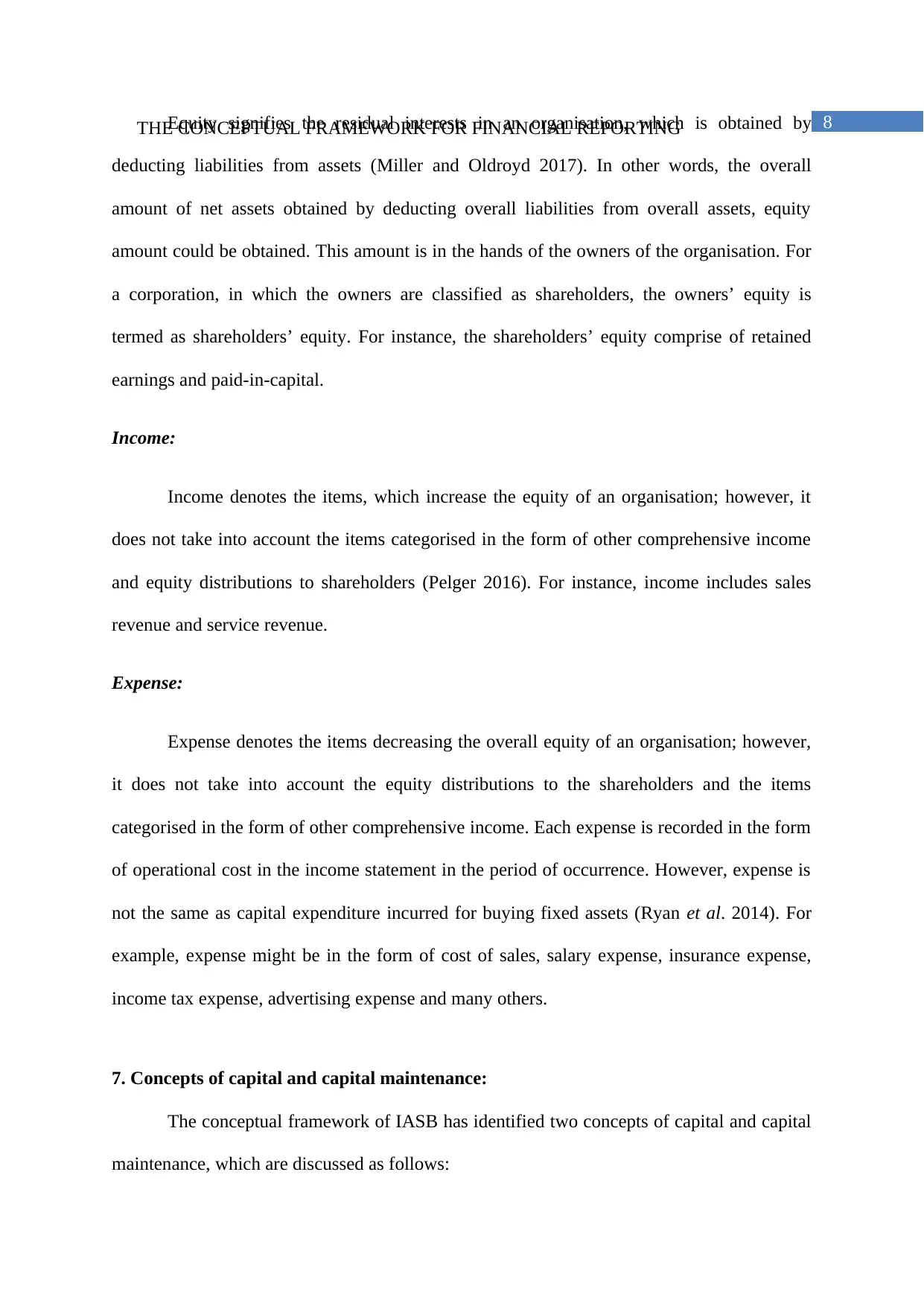
8THE CONCEPTUAL FRAMEWORK FOR FINANCIAL REPORTINGEquity signifies the residual interests in an organisation, which is obtained by
deducting liabilities from assets (Miller and Oldroyd 2017). In other words, the overall
amount of net assets obtained by deducting overall liabilities from overall assets, equity
amount could be obtained. This amount is in the hands of the owners of the organisation. For
a corporation, in which the owners are classified as shareholders, the owners’ equity is
termed as shareholders’ equity. For instance, the shareholders’ equity comprise of retained
earnings and paid-in-capital.
Income:
Income denotes the items, which increase the equity of an organisation; however, it
does not take into account the items categorised in the form of other comprehensive income
and equity distributions to shareholders (Pelger 2016). For instance, income includes sales
revenue and service revenue.
Expense:
Expense denotes the items decreasing the overall equity of an organisation; however,
it does not take into account the equity distributions to the shareholders and the items
categorised in the form of other comprehensive income. Each expense is recorded in the form
of operational cost in the income statement in the period of occurrence. However, expense is
not the same as capital expenditure incurred for buying fixed assets (Ryan et al. 2014). For
example, expense might be in the form of cost of sales, salary expense, insurance expense,
income tax expense, advertising expense and many others.
7. Concepts of capital and capital maintenance:
The conceptual framework of IASB has identified two concepts of capital and capital
maintenance, which are discussed as follows:
deducting liabilities from assets (Miller and Oldroyd 2017). In other words, the overall
amount of net assets obtained by deducting overall liabilities from overall assets, equity
amount could be obtained. This amount is in the hands of the owners of the organisation. For
a corporation, in which the owners are classified as shareholders, the owners’ equity is
termed as shareholders’ equity. For instance, the shareholders’ equity comprise of retained
earnings and paid-in-capital.
Income:
Income denotes the items, which increase the equity of an organisation; however, it
does not take into account the items categorised in the form of other comprehensive income
and equity distributions to shareholders (Pelger 2016). For instance, income includes sales
revenue and service revenue.
Expense:
Expense denotes the items decreasing the overall equity of an organisation; however,
it does not take into account the equity distributions to the shareholders and the items
categorised in the form of other comprehensive income. Each expense is recorded in the form
of operational cost in the income statement in the period of occurrence. However, expense is
not the same as capital expenditure incurred for buying fixed assets (Ryan et al. 2014). For
example, expense might be in the form of cost of sales, salary expense, insurance expense,
income tax expense, advertising expense and many others.
7. Concepts of capital and capital maintenance:
The conceptual framework of IASB has identified two concepts of capital and capital
maintenance, which are discussed as follows:
⊘ This is a preview!⊘
Do you want full access?
Subscribe today to unlock all pages.

Trusted by 1+ million students worldwide
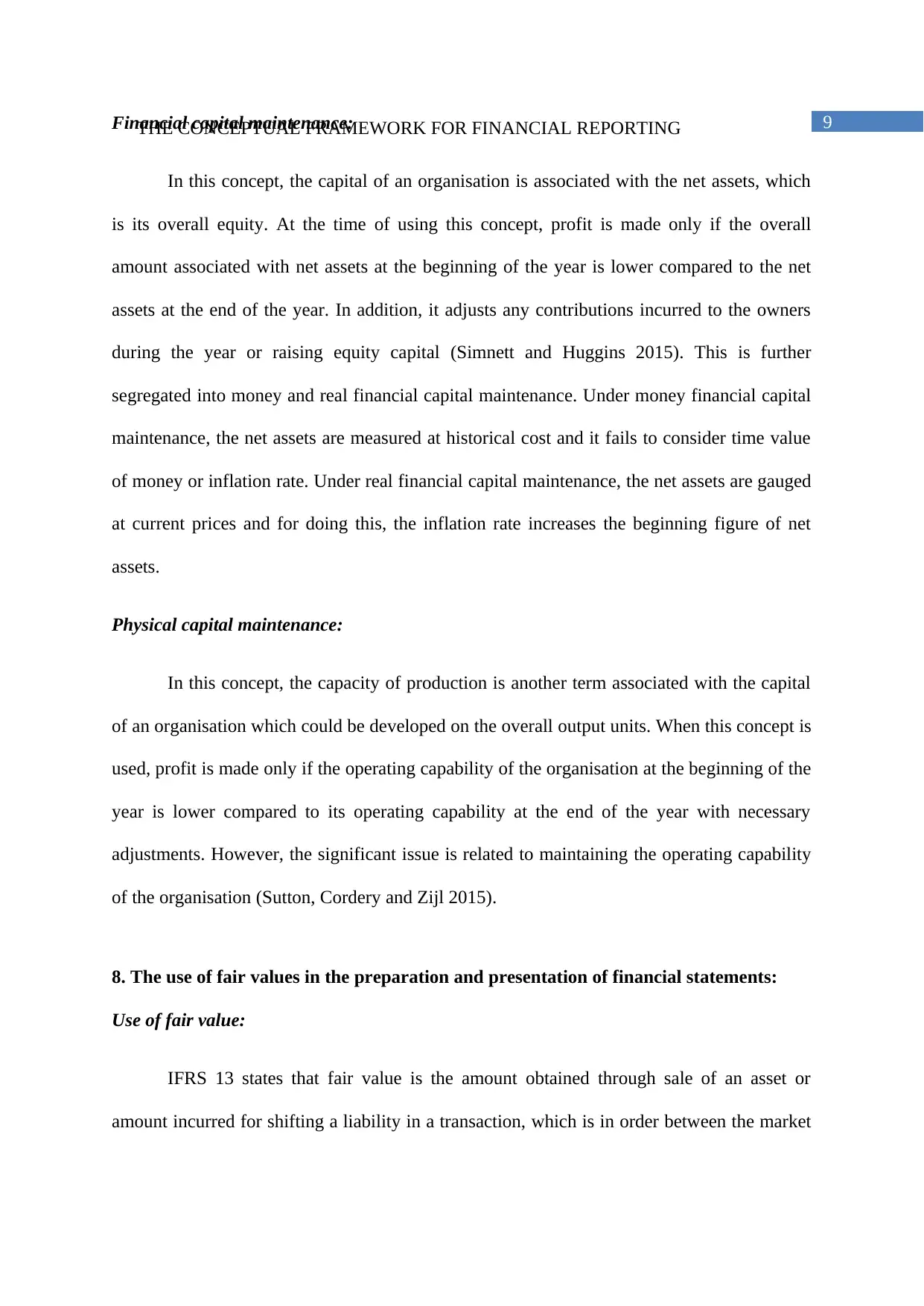
9THE CONCEPTUAL FRAMEWORK FOR FINANCIAL REPORTINGFinancial capital maintenance:
In this concept, the capital of an organisation is associated with the net assets, which
is its overall equity. At the time of using this concept, profit is made only if the overall
amount associated with net assets at the beginning of the year is lower compared to the net
assets at the end of the year. In addition, it adjusts any contributions incurred to the owners
during the year or raising equity capital (Simnett and Huggins 2015). This is further
segregated into money and real financial capital maintenance. Under money financial capital
maintenance, the net assets are measured at historical cost and it fails to consider time value
of money or inflation rate. Under real financial capital maintenance, the net assets are gauged
at current prices and for doing this, the inflation rate increases the beginning figure of net
assets.
Physical capital maintenance:
In this concept, the capacity of production is another term associated with the capital
of an organisation which could be developed on the overall output units. When this concept is
used, profit is made only if the operating capability of the organisation at the beginning of the
year is lower compared to its operating capability at the end of the year with necessary
adjustments. However, the significant issue is related to maintaining the operating capability
of the organisation (Sutton, Cordery and Zijl 2015).
8. The use of fair values in the preparation and presentation of financial statements:
Use of fair value:
IFRS 13 states that fair value is the amount obtained through sale of an asset or
amount incurred for shifting a liability in a transaction, which is in order between the market
In this concept, the capital of an organisation is associated with the net assets, which
is its overall equity. At the time of using this concept, profit is made only if the overall
amount associated with net assets at the beginning of the year is lower compared to the net
assets at the end of the year. In addition, it adjusts any contributions incurred to the owners
during the year or raising equity capital (Simnett and Huggins 2015). This is further
segregated into money and real financial capital maintenance. Under money financial capital
maintenance, the net assets are measured at historical cost and it fails to consider time value
of money or inflation rate. Under real financial capital maintenance, the net assets are gauged
at current prices and for doing this, the inflation rate increases the beginning figure of net
assets.
Physical capital maintenance:
In this concept, the capacity of production is another term associated with the capital
of an organisation which could be developed on the overall output units. When this concept is
used, profit is made only if the operating capability of the organisation at the beginning of the
year is lower compared to its operating capability at the end of the year with necessary
adjustments. However, the significant issue is related to maintaining the operating capability
of the organisation (Sutton, Cordery and Zijl 2015).
8. The use of fair values in the preparation and presentation of financial statements:
Use of fair value:
IFRS 13 states that fair value is the amount obtained through sale of an asset or
amount incurred for shifting a liability in a transaction, which is in order between the market
Paraphrase This Document
Need a fresh take? Get an instant paraphrase of this document with our AI Paraphraser
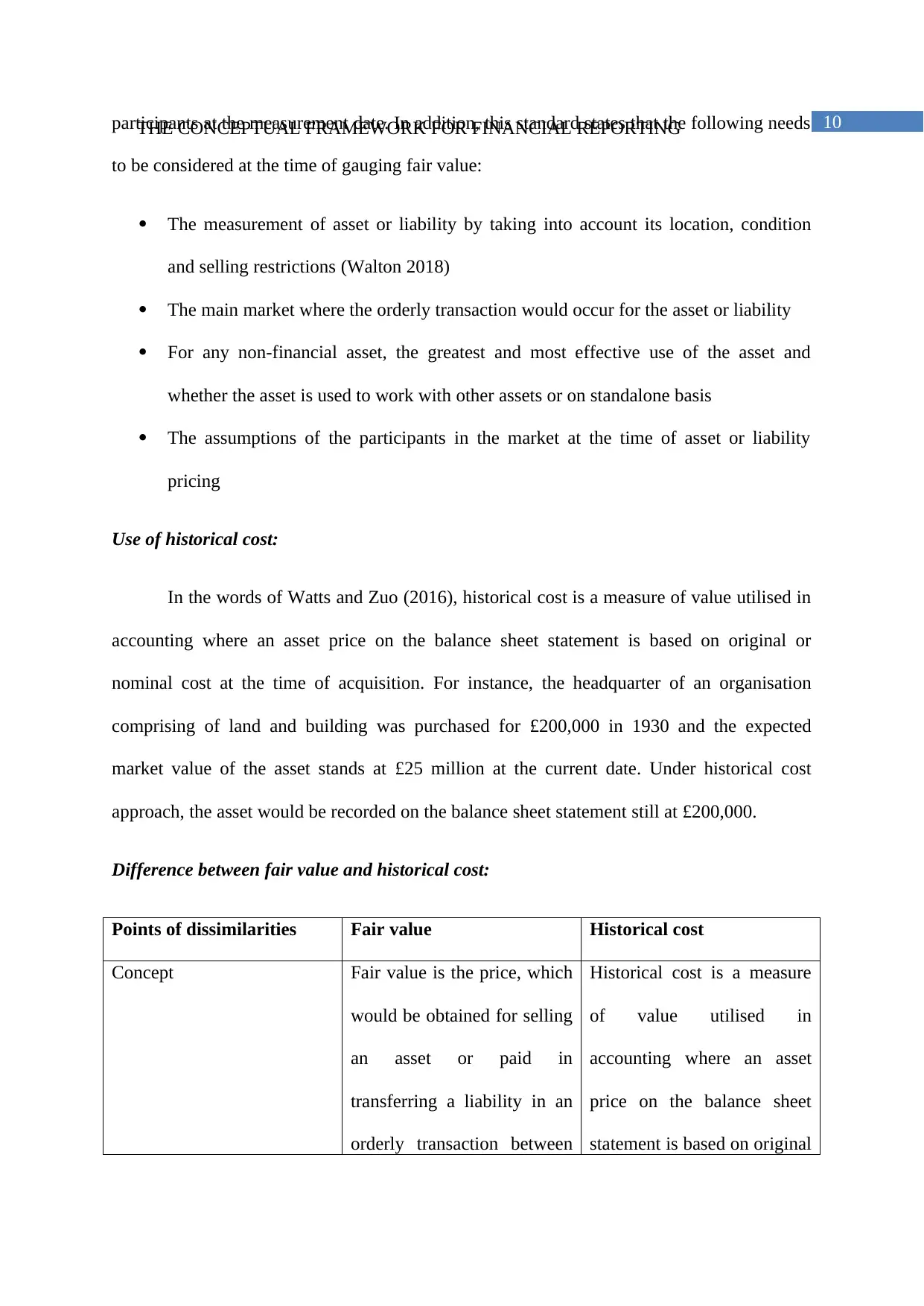
10THE CONCEPTUAL FRAMEWORK FOR FINANCIAL REPORTINGparticipants at the measurement date. In addition, this standard states that the following needs
to be considered at the time of gauging fair value:
The measurement of asset or liability by taking into account its location, condition
and selling restrictions (Walton 2018)
The main market where the orderly transaction would occur for the asset or liability
For any non-financial asset, the greatest and most effective use of the asset and
whether the asset is used to work with other assets or on standalone basis
The assumptions of the participants in the market at the time of asset or liability
pricing
Use of historical cost:
In the words of Watts and Zuo (2016), historical cost is a measure of value utilised in
accounting where an asset price on the balance sheet statement is based on original or
nominal cost at the time of acquisition. For instance, the headquarter of an organisation
comprising of land and building was purchased for £200,000 in 1930 and the expected
market value of the asset stands at £25 million at the current date. Under historical cost
approach, the asset would be recorded on the balance sheet statement still at £200,000.
Difference between fair value and historical cost:
Points of dissimilarities Fair value Historical cost
Concept Fair value is the price, which
would be obtained for selling
an asset or paid in
transferring a liability in an
orderly transaction between
Historical cost is a measure
of value utilised in
accounting where an asset
price on the balance sheet
statement is based on original
to be considered at the time of gauging fair value:
The measurement of asset or liability by taking into account its location, condition
and selling restrictions (Walton 2018)
The main market where the orderly transaction would occur for the asset or liability
For any non-financial asset, the greatest and most effective use of the asset and
whether the asset is used to work with other assets or on standalone basis
The assumptions of the participants in the market at the time of asset or liability
pricing
Use of historical cost:
In the words of Watts and Zuo (2016), historical cost is a measure of value utilised in
accounting where an asset price on the balance sheet statement is based on original or
nominal cost at the time of acquisition. For instance, the headquarter of an organisation
comprising of land and building was purchased for £200,000 in 1930 and the expected
market value of the asset stands at £25 million at the current date. Under historical cost
approach, the asset would be recorded on the balance sheet statement still at £200,000.
Difference between fair value and historical cost:
Points of dissimilarities Fair value Historical cost
Concept Fair value is the price, which
would be obtained for selling
an asset or paid in
transferring a liability in an
orderly transaction between
Historical cost is a measure
of value utilised in
accounting where an asset
price on the balance sheet
statement is based on original
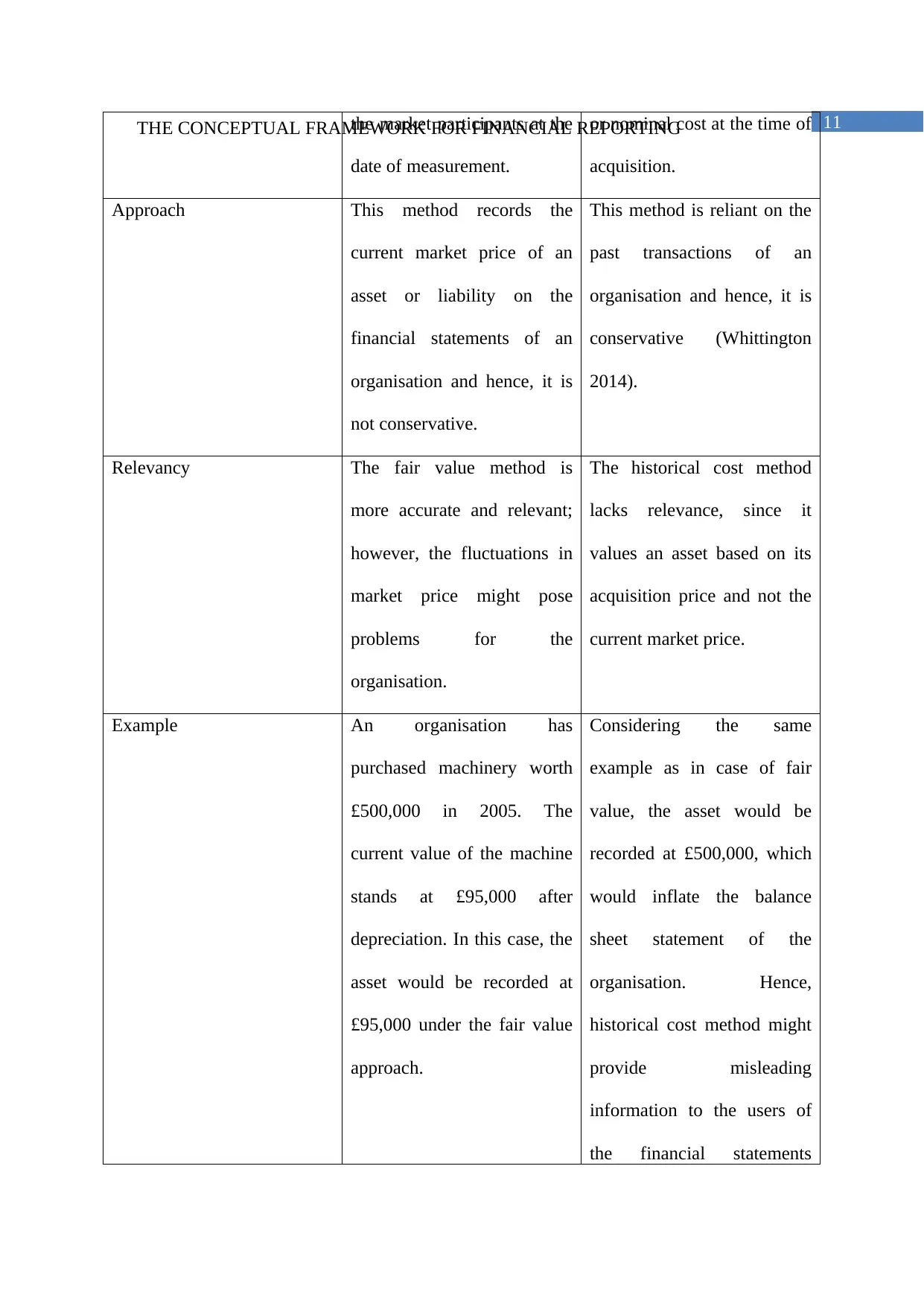
11THE CONCEPTUAL FRAMEWORK FOR FINANCIAL REPORTINGthe market participants at the
date of measurement.
or nominal cost at the time of
acquisition.
Approach This method records the
current market price of an
asset or liability on the
financial statements of an
organisation and hence, it is
not conservative.
This method is reliant on the
past transactions of an
organisation and hence, it is
conservative (Whittington
2014).
Relevancy The fair value method is
more accurate and relevant;
however, the fluctuations in
market price might pose
problems for the
organisation.
The historical cost method
lacks relevance, since it
values an asset based on its
acquisition price and not the
current market price.
Example An organisation has
purchased machinery worth
£500,000 in 2005. The
current value of the machine
stands at £95,000 after
depreciation. In this case, the
asset would be recorded at
£95,000 under the fair value
approach.
Considering the same
example as in case of fair
value, the asset would be
recorded at £500,000, which
would inflate the balance
sheet statement of the
organisation. Hence,
historical cost method might
provide misleading
information to the users of
the financial statements
date of measurement.
or nominal cost at the time of
acquisition.
Approach This method records the
current market price of an
asset or liability on the
financial statements of an
organisation and hence, it is
not conservative.
This method is reliant on the
past transactions of an
organisation and hence, it is
conservative (Whittington
2014).
Relevancy The fair value method is
more accurate and relevant;
however, the fluctuations in
market price might pose
problems for the
organisation.
The historical cost method
lacks relevance, since it
values an asset based on its
acquisition price and not the
current market price.
Example An organisation has
purchased machinery worth
£500,000 in 2005. The
current value of the machine
stands at £95,000 after
depreciation. In this case, the
asset would be recorded at
£95,000 under the fair value
approach.
Considering the same
example as in case of fair
value, the asset would be
recorded at £500,000, which
would inflate the balance
sheet statement of the
organisation. Hence,
historical cost method might
provide misleading
information to the users of
the financial statements
⊘ This is a preview!⊘
Do you want full access?
Subscribe today to unlock all pages.

Trusted by 1+ million students worldwide
1 out of 15
Related Documents
Your All-in-One AI-Powered Toolkit for Academic Success.
+13062052269
info@desklib.com
Available 24*7 on WhatsApp / Email
![[object Object]](/_next/static/media/star-bottom.7253800d.svg)
Unlock your academic potential
Copyright © 2020–2025 A2Z Services. All Rights Reserved. Developed and managed by ZUCOL.




